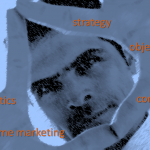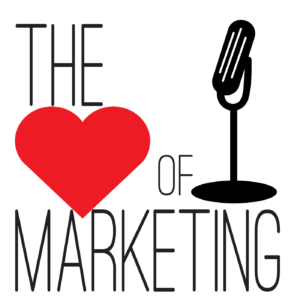What kind of content will the people you hope to influence truly value?
Not something they snack on like a bag of chips and are soon hungry for something else. But nourishing content that sticks to the ribs and gives them something they really want.
It’s a question I had the opportunity to ask Ann Handley, Chief Content Officer of MarketingProfs recently. It begins with a mindset of generosity, she told me. “Instead of just talking about your stuff and creating more marketing messages, think about giving people content gifts,” she said.
How can marketers put this mindset into their content strategy?
Ann shares her insights on this in these edited highlights from her interview on The Heart of Marketing.
You recently put the idea out there that marketers need to slow down. What do you mean by ‘slow marketing’?
Slow marketing is really just an approach that asks marketers, business owners, and entrepreneurs to slow down a little bit at certain key moments in order to produce marketing that actually will get results.
I talk to a lot of marketers, a lot of business owners, who sort of slosh right in and get right into marketing without a clear sense of a few things. In my mind, it’s really important to slow down at certain key areas.
One area is to know who you’re talking to, getting to know your customer better – really pausing to develop a keen sense of empathy for the problems your customers have, and the solutions you can offer them.
A second area is really getting to know yourself. Really being able to articulate your own story. And your story is not what you do or what you sell. It’s deeper than that. I’m challenging marketers and business owners to really think more carefully in those two areas, and slow down a little bit.
So before you start talking, figure out who you’re talking to. Figure out what value you can really offer them. And secondly, really understand what your story is and where you fit into the lives of your customers in a more substantive way.
Where do content marketers need to slow down their approach?
In marketing, I think we have a bad habit of saying what we need to say instead of what the customer needs to know from us. And I totally get that. I understand how it happens from a marketing point of view from the people I talk to.
Very often their marketing comes from a deadline that is looming. We’re pressed to get something or anything off our desk. We have to create a campaign, we have to write an email, we have to post to social media.
As a result of that, we shortcut something important. Which is to develop more customer-centric messaging, or audience-centric messaging, to think more broadly about an audience.
I think the worst place to start a piece of content – and by content I mean any campaign you’re working on, or any marketing collateral, or anything, is not with ‘We need a piece of content for’ … blank. I think it’s more important to start with, ‘Our customer needs … blank.’ What? What does your customer need? Start there. It’s just an easy way of automatically thinking more from a customer-centric point of view.
There has been a lot of conversation going on about creating customer experiences. What does that mean for content marketing?
What that means is thinking through all the ways your customer touches you or your business, and then extending a similar feel, a similar experience, a similar brand message, all across everything. So when I think about content experiences, that’s what I think about.
I don’t think about things like virtual reality experiences, because that’s something maybe one percent of brands in the next few years are going to be able to embrace. And few brands have a jillion dollar budget, right?
Instead, try to think outside of your own job. Try on your customer’s skin for a while. Walk around in their shoes and see what it feels like when they come to your event, or website, or social channels. Are you delivering a similar experience? That’s how I think about experience.
A lot of what you’re talking about here can be summed up with the word ‘empathy.’ This is an idea that’s been around for a while. Why do you think it is such a challenge for businesses to show empathy in their marketing?
You’re right. The notion of thinking about things from your customer’s point of view has been around for a long time. But I think the reason why it’s on our radar in such a big way recently is because we have so many more opportunities to communicate with our customers now.
Think about just the opportunities of social media. And even more recent things, like through bots, through Facebook Messenger, through Snapchat. There’s just so many different ways.
So, as a result I think it’s challenging us to really think about what our customers need from us. It goes back to your original question about slow marketing. This is why I think it’s so important to think through your business from your customers’ point of view. It is the heart of all great marketing.
One thing customers really seem to like is video. Video content consumption continues to rise. So does the amount of video content businesses are producing. What does the future hold for written content?
I think video is incredibly valuable. Where I stop short, though, is saying that writing is somehow dead or that it’s ever going to be replaced by video. I have a hard time imagining a world in which that’s true, only because there is an awful lot that you can convey in writing that you can’t convey in video. So, I guess I don’t see it as a zero-sum prospect.
In my mind, it’s not a bad thing to see the rise of video and to see it replacing some short-form blog posts in certain situations. But I don’t think that means there’s no place for writing, particularly long form writing. I think that there is always going to be a place for that in content marketing.
So, that’s the first thing I’d say.
The second thing I’d say is that quite often video is played on silent mode on social channels. I think about the way that I consume video on Facebook, for example. So, I think there’s a real opportunity there to think about some well-chosen words to accompany the video. Quite often it’ll just be closed captioning. That’s fine. But I also think that there’s an opportunity there to really pay attention to the words that you’re using to accompany the video.
There’s a real opportunity to think about some well-chosen words to accompany video.
It’s the same with Instagram captions. Don’t just default to stating the obvious. You can use words to tell a bigger story.
If you’re selling lattes, and you’re showing a picture of your latte with a heart on top, don’t just write, “Love latte art.” Tell us a little about that. Words and images and video can work really well together if you take the opportunity to tell a richer and more robust story.
If you were asked to leave people with the one thing that’s most critical to content marketing success, what would it be?
We’ve talked about some really serious things here in terms of strategy and thinking through your customer experience and pathological empathy, and all that stuff, but you know what? At the end of the day, there’s one thing that’s most important to content marketing success …
***
Hear Ann’s surprising answer to that question and much more about empathy, generosity, creating value, customer experience, and content marketing strategy in the complete interview on The Heart of Marketing.













Speak Your Mind